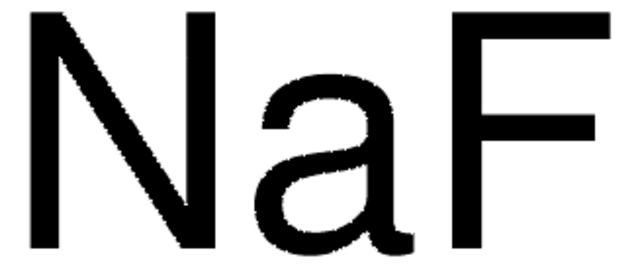71387
Sodium chloride
reference material for titrimetry, certified by BAM, >99.5%
Synonym(s):
Halite, NaCl
Sign Into View Organizational & Contract Pricing
All Photos(1)
About This Item
Linear Formula:
NaCl
CAS Number:
Molecular Weight:
58.44
Beilstein/REAXYS Number:
3534976
EC Number:
MDL number:
UNSPSC Code:
12352302
PubChem Substance ID:
NACRES:
NA.24
Recommended Products
grade
reference material
Quality Level
vapor pressure
1.33 (1.00 mmHg) at 865 °C hPa
assay
>99.5%
quality
certified by BAM
technique(s)
titration: suitable
pH
7
mp
801 °C (lit.)
solubility
water: soluble (358 g/l at 20 °C (68 °F))
format
neat
SMILES string
[Na+].[Cl-]
InChI
1S/ClH.Na/h1H;/q;+1/p-1
InChI key
FAPWRFPIFSIZLT-UHFFFAOYSA-M
Looking for similar products? Visit Product Comparison Guide
General description
Sodium chloride (NaCl) is a volumetric standard manufactured under rigorous conditions and analyzed with the highest possible precision. The content of the standard is measured by volumetric argentometric titration and the measurement can be traced back to NIST SRM. Its certified value and uncertainty measurement are in accordance with ISO Guide 35.
Application
It finds its use as a certified reference material (CRM) for the standardization of volumetric solutions in argentometric titrations.
Features and Benefits
- Available as a solid in a contamination-proof glass bottle to ensure its stability for the entire shelf life until opened.
- High-purity material traceable to SRMs from NIST
- High-quality offering accurate titer determinations
- Accompanied by a certificate of analysis (CoA)
Analysis Note
Exact concentration, expiry date, traceability and detailed information on certification can be found on the certificate and certification report, included in each package. Content and expiry date on label.
Storage Class
11 - Combustible Solids
wgk_germany
WGK 1
flash_point_f
Not applicable
flash_point_c
Not applicable
ppe
Eyeshields, Gloves, type N95 (US)
Choose from one of the most recent versions:
Already Own This Product?
Find documentation for the products that you have recently purchased in the Document Library.
Customers Also Viewed
Determination of chloride in infant formula and adult/pediatric nutritional formula by automated potentiometry: Single-Laboratory Validation, First Action 2015.08.
Jaudzems.GG
Journal of AOAC (Association of Official Analytical Chemists) International, 98, 1390-1394 (2015)
Francis Kim et al.
JAMA, 311(1), 45-52 (2013-11-19)
Hospital cooling improves outcome after cardiac arrest, but prehospital cooling immediately after return of spontaneous circulation may result in better outcomes. To determine whether prehospital cooling improves outcomes after resuscitation from cardiac arrest in patients with ventricular fibrillation (VF) and
Laurent Dortet et al.
Journal of clinical microbiology, 52(7), 2359-2364 (2014-04-25)
Multidrug-resistant Acinetobacter baumannii isolates, particularly those that produce carbapenemases, are increasingly reported worldwide. The biochemically based Carba NP test, extensively validated for the detection of carbapenemase producers among Enterobacteriaceae and Pseudomonas spp., has been modified to detect carbapenemase production in
Alexander W Wyatt et al.
Genome biology, 15(8), 426-426 (2014-08-27)
Genomic analyses of hundreds of prostate tumors have defined a diverse landscape of mutations and genome rearrangements, but the transcriptomic effect of this complexity is less well understood, particularly at the individual tumor level. We selected a cohort of 25
Koji Tanaka et al.
Nature communications, 6, 6337-6337 (2015-02-27)
Pore-forming toxins (PFT) are water-soluble proteins that possess the remarkable ability to self-assemble on the membrane of target cells, where they form pores causing cell damage. Here, we elucidate the mechanism of action of the haemolytic protein fragaceatoxin C (FraC)
Our team of scientists has experience in all areas of research including Life Science, Material Science, Chemical Synthesis, Chromatography, Analytical and many others.
Contact Technical Service




